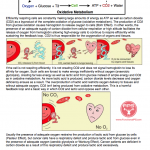Also see:
Comparison: Carbon Dioxide v. Lactic Acid
Carbon Dioxide as an Antioxidant
Bohr Effect and Cells O2 Levels: Healthy vs. Sick People
Comparison: Oxidative Metabolism v. Glycolytic Metabolic
Promoters of Efficient v. Inefficient Metabolism
Altitude Sickness: Therapeutic Effects of Acetazolamide and Carbon Dioxide
Low CO2 in Hypothyroidism
Protective Altitude
Lactate Paradox: High Altitude and Exercise
Protective Carbon Dioxide, Exercise, and Performance
Synergistic Effect of Creatine and Baking Soda on Performance
Ray Peat, PhD on Carbon Dioxide, Longevity, and Regeneration
Altitude Improves T3 Levels
Mitochondria & Mortality
Altitude and Mortality
Lactate vs. CO2 in wounds, sickness, and aging; the other approach to cancer
Carbonic Anhydrase Inhibitors as Cancer Therapy
Click on thumbnail.
“When respiration is suppressed, the cell’s production of carbon dioxide is suppressed. If we start with the best known example of carbon dioxide’s effect on a protein, the Haldane-Bohr effect on hemoglobin, we will have a model for visualizing what happens to organisms in an environment that is poor in carbon dioxide, but rich in vegetable-derived unsaturated fats. Carbon dioxide associates with protein in a variety of ways, but the best understood association is its reaction with an amino group, to form a carbamino group. In the presence of a large amount of carbon dioxide, the hemoglobin molecule changes its shape slightly, along with its electronic balance, in a way that favors the release of oxygen. The opposite happens in the presence of a high concentration of oxygen and a lower concentration of carbon dioxide.” -Ray Peat, PhD

